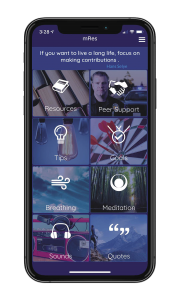The public safety field can be full of traumatic experiences that could result in long-term effects. About 80 percent of first responders will experience a mental health–related issue in their careers.1
Law enforcement officers are aware of this but are still the first to run into the line of fire to serve their communities. They often have little time between calls to effectively process an experience before responding to the next, unknowingly allowing stress to build.
As mental health–related concerns accumulate, first responders are at a greater risk for developing more adverse conditions. But police are known to hesitate to get support for these concerns. A 2020 study found that about 70 of the 430 police officers surveyed used the mental health resources available to them during the year.2 Navigating the steps needed to identify and access resources can be overwhelming for first responders who are already hesitant to seek help; therefore, it is important for leadership to guide them in the right direction of what’s available.
Using Technology to Advance Accessibility
What better place to start driving officers to engage in their own wellness than mobile devices? Mobile health applications can address many of the accessibility and confidentiality concerns of the programs and services officers need.
Lighthouse Health and Wellness (Lighthouse)—a FirstNet, Built with AT&T, sponsored application—offers a range of resources in one mobile application and web portal to address these accessibility challenges. “At it’s core, Lighthouse strives to ensure public safety agencies can provide employees and their families with high-quality, confidential, and anonymous access to health and wellness resources,” said Dr. Anna Fitch Courie, director of responder wellness at FirstNet.3
Working directly with police departments, Lighthouse integrates available tools, resources, and vetted providers into the platform. The goal is to provide a one-stop-shop for officer safety and wellness that can be accessed at any time. When officers enter the application, they get immediate access to a comprehensive library of information on a variety of topics, ranging from emotional survival and financial wellness to physical health and peer support. In addition, officers can search for first responder–specific chaplains and therapists by location.
Agencies can even customize the platform and send notifications to all of their officers, driving them to the specific wellness information the department wants to emphasize.
“Because of their shift work, highly mobile profession, and a fierce desire for confidentiality, law enforcement officers are a prime population for mHealth applications,” said Dr. Courie.

In 2015, the San Bernardino, California, mass shooting served as a call to action for Dalita Harmon, The Information Applications Group (TIAG)’s chief executive officer. She felt confident her team knew how to create an effective product specifically for civilian law enforcement to help officers to manage stress and improve health. Over the course of the next three years, TIAG’s multidisciplinary product development team undertook a comprehensive research and development process, resulting in the mResilience (mRes) mobile application and training program.
“Our approach from the beginning was on the skills, techniques, and resources to help build and maintain resilience—and provide a path to vetted resources for the times when help is needed,” said Steve Vincent, TIAG’s technology partnerships manager.4
The mRes mobile app includes a core set of tools and resources for mindfulness, breathing regulation, and guided meditation, among many others, that provide the user with evidence-based strategies for reducing stress. These tools are combined with a peer support module that allows users to anonymously reach out for help. The app is supplemented by optional resilience training delivered either in person or virtually to help reinforce the “science of why” stress affects the body and how the tools can help offset this.
“The real power is in the ability for an organization to easily tailor the content and keep it dynamically updated so that changes are reflected in near time for end users,” said Vincent. A user is able to anonymously access the full range of organizational content with the hope that they will explore new techniques and engage content without the concern of being monitored by leadership.
Through the team’s research phase, they acknowledged that officers tend to be inherently skeptical of any technology that could be used to monitor end users. To address this concern, TIAG designed mRes in such a way that only authorized users can access department-specific content. The program does not gather specific user data, personally identifiable information, or personal health information. Other than knowing who the authorized pool of users is, the only other analytics are de-identified, aggregate user metrics, which allow the agency to assess which tools are being used most frequently and for how long.
Transforming Agency Culture

Multiple organizations have recognized that the environment of the workplace itself can also be a source of stress for officers rather than calmness.
Aiming to transform agency culture, Being First, Inc., provides a comprehensive online wellness program. “Fundamentally, our belief is that police, as an industry, are pivotal to our civil society and that society is asking for something different from police departments,” said Dr. Dean Anderson, chief executive officer and cofounder of Being First.5 Recognizing that communities are asking for a change, the Being First team believes this could be accomplished by helping police chiefs understand transformation and how to uplevel their organizations, systems, culture, and leadership to better serve society’s needs.
For four years, Being First has built a system for transformation that addresses leadership, culture, change in organization systems, and employee empowerment and wellness. The employee wellness component of the larger program is oriented to self-mastery, which the company thinks of as building an officers’ self-awareness and self-management capabilities so that they can operate at a high-performance level amid challenging situations.

The foundation of the employee wellness component consists of two core curriculums: (1) Walk the Talk of Change for police leadership and (2) the self-mastery curriculum that is provided throughout the agency. “What’s fundamentally different about what we do is that we don’t talk about what needs to change. We actually teach people how,” said Dr. Anderson. The 10-week self-mastery curriculum provides pragmatic field development that enables personnel to manage their mindset, their emotions, and their behavior for optimal performance. “It’s not just [about] wellness in the workplace, it’s wellness in their life.”
A nonprofit organization has also been known to transform a stressful workplace environment through stress management tools—that have fur. Mutts With A Mission founder, Brooke Corson, was inspired by the positive impact that her dog, Angus, had on troops returning to Fort Benning in Georgia from oversea deployments.6 Although originally founded as a way to assist veterans living with post-traumatic stress disorder and mobility disabilities, in 2019, Mutts With A Mission expanded its program to place service dogs with first responders and law enforcement. This is done at no cost to the recipients.
With full accreditation from Assistance Dogs International, the team also provides Facility Dogs to agencies across the United States. “These dogs are useful tools for peer support and Critical Incident Stress Management teams as they help facilitate conversations that may not have taken place without the dog being present,” said Executive Director Brooke Corson.7
Stemming from a conversation with a local police department and their need for a facility dog, Mutts With A Mission started providing dogs to first responders in 2019. Since then, the awareness of facility dogs and their benefits to agency personnel have become more accepted and has helped to reduce the stigma associated with mental health.
The facility dogs undergo the same rigorous training as service dogs, but rather than helping with a disability, facility dogs (like therapy dogs) assist people to cope after a traumatic incident or in an overly stressful environment.8 Having daily interactions with a facility dog allows officers to perform their duties with a different outlook and leave the workplace with a more positive mindset.
Law enforcement officers often serve their communities without thinking about their own needs. These brave efforts often take a toll on an officer’s well-being. Luckily, there are various companies who are aiming to reduce the stigma around police asking for help and bring awareness to the resources available to the field.d
Notes:
1Holly Kennedy-Hansen, “How Employers Can Help First Responders Stay Mentally and Emotionally Strong,” Insights (blog) November 18, 2020.
2Katelyn K. Jetelina et al., “Prevalence of Mental Illness and Mental Health Care Use among Police Officers,” JAMA Network Open 3, no. 10, October 7, 2020, e2019658.
3Anna Fitch Courie (director of first responder wellness, FirstNet, Built with AT&T), email interview, June 13, 2022.
4Steve Vincent (technology partnerships manager, TIAG), email interview, May 26, 2022.
5Dean Anderson (CEO/cofounder, Being First, Inc.), phone interview, May 25, 2022.
6Mutts With A Mission, “About Us.”
7Brooke Corson (founder/executive director, Mutts With A Mission), email interview, May 31, 2022.
8Mutts With A Mission, “Facility Dog Applications.”
|
SOURCE LIST Please click on the companies’ names to go to their websites or visit the Police Chief Buyers’ Guide to request information from companies. |
||
|
|
|
|


